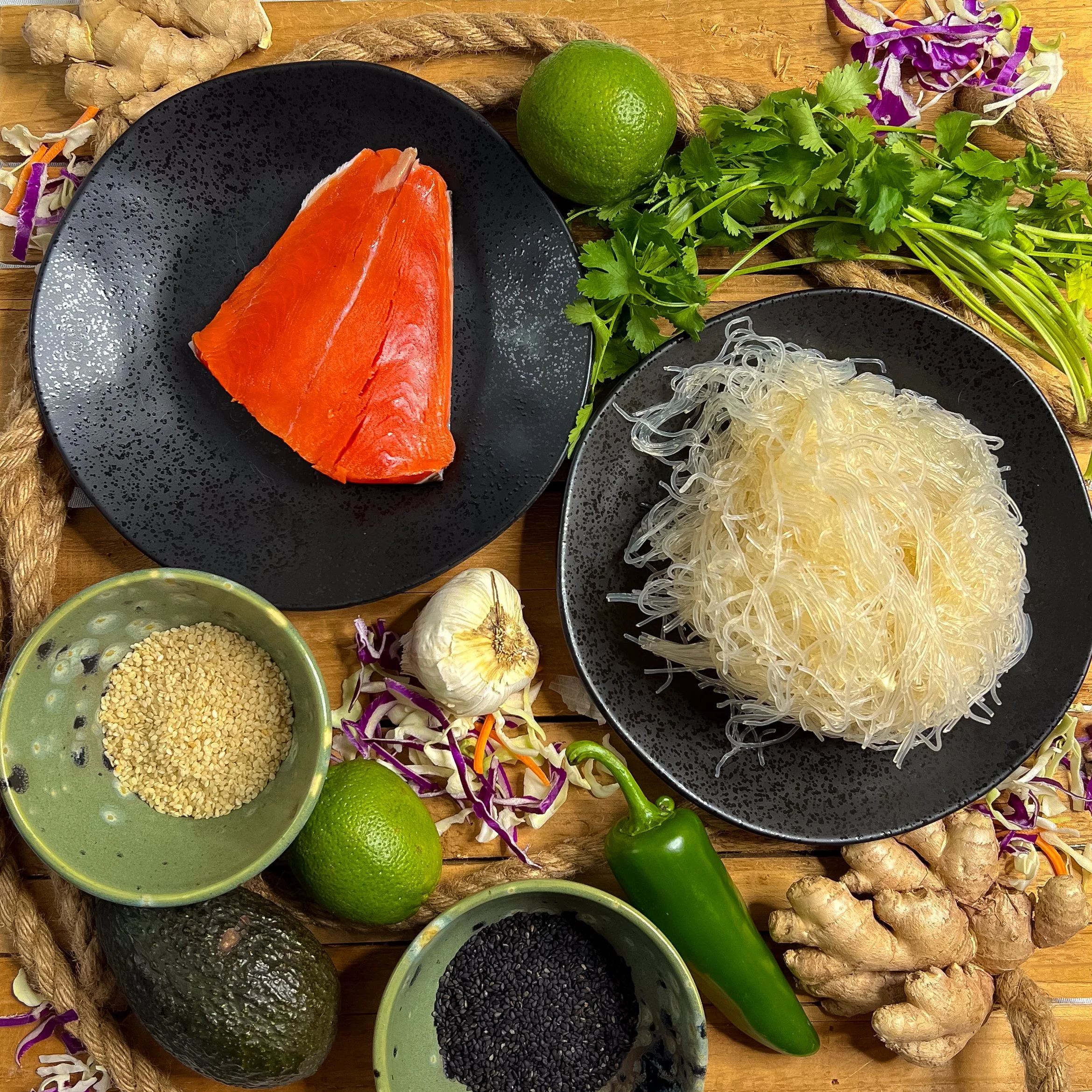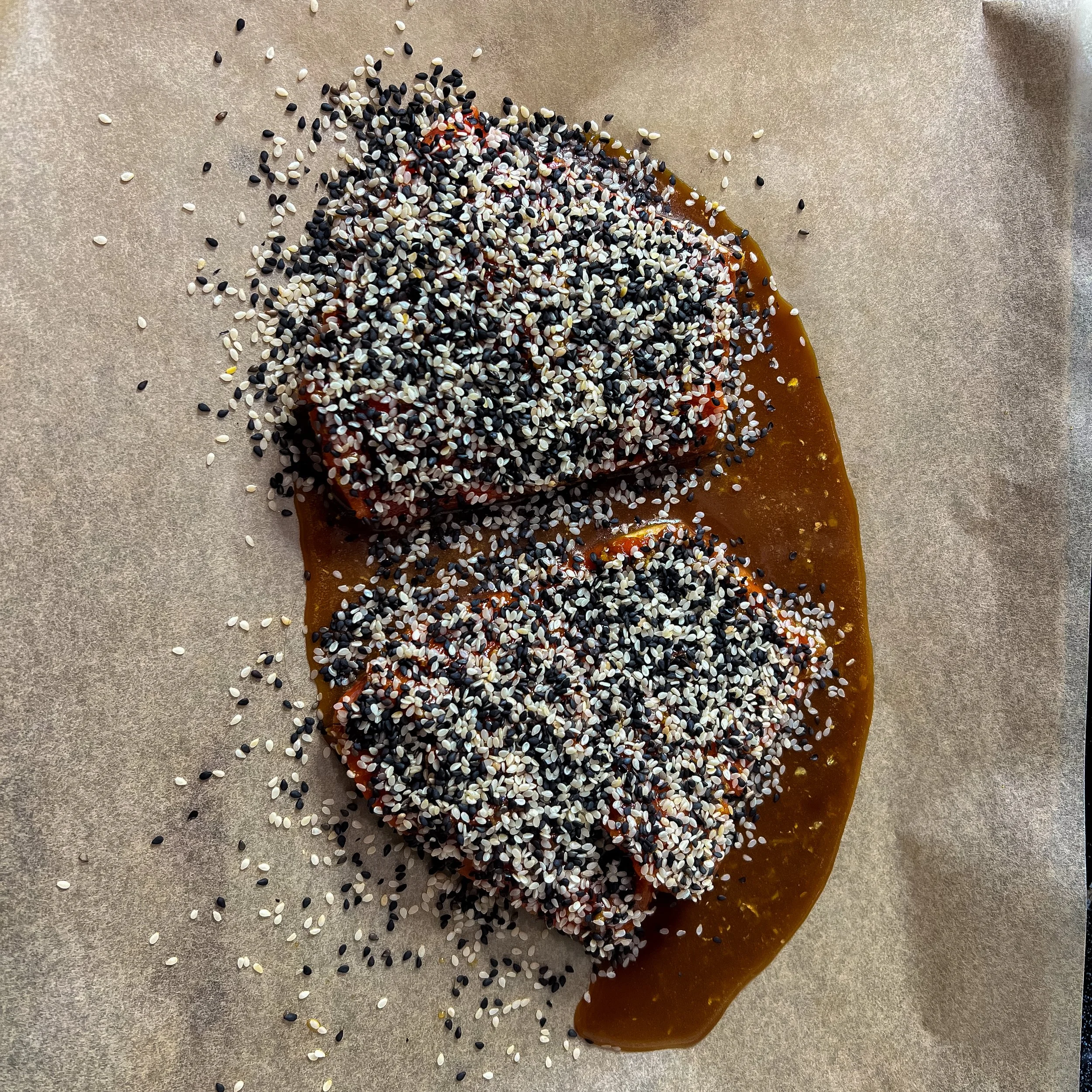Healthy Eating: Salmon and Kelp Noodles
This recipe is Kelly's current obsession. It is a dish that she came up with, and cooks every time she can. That's always an exciting thing for me— it's nice when your wife is proud of her accomplishments, and we get to try an ingredient that I wouldn't have picked out on my own. An ingredient like kelp noodles.
Before we get to the kelp noodles, there's a lot more going on here. The salmon is marinated, coated in sesame seeds, and baked. There's also a delicious cabbage slaw with garlic, ginger, and a touch of lemon. Sure— you could combine those ingredients over a bed of rice and have a satisfying, tasty meal. The thing is, taking a step outside the box is what elevates a meal from a satisfying Wednesday night dinner to a dish you think about and want to make again. That's where the kelp noodles come in.
Why eat kelp noodles?
Kelp noodles are not your average noodle. First off, they are not made from wheat, rice, or any other typical "noodle" ingredient. Kelp is the one and only ingredient in these noodles. They're a versatile ingredient that can be used raw or lightly cooked in water and spices, like we do in this recipe.
Kelp noodles are certainly not a replacement for pasta noodles. Their flavor and texture is entirely different, and they should be treated as their own thing with dishes that play to their strengths. Kelp noodles are slightly crunchy and have a mild flavor.
From a nutrition standpoint, kelp noodles have the benefit of having an extremely low footprint on your dish. They are low in calories, have no fat, no cholesterol, and low carbohydrates. A four-ounce serving of kelp noodles has around 12% of the recommended daily value of calcium, and 4% of your daily iron intake. The big benefit of kelp, though, is its iodine content. That same four-ounce serving has roughly one third of the iodine needed for a healthy diet.
Iodine is an absolutely vital nutrient for a healthy body, and iodine deficiency is a common condition. Iodine supports the thyroid gland, which in turn affects nerve, bone, and metabolic health. Iodine is especially important for pregnant women and young children, as it contributes to the development of the brain and nervous system. It is recommended that adults get 150 micrograms of iodine per day, but pregnant women need 220 mcg, and breastfeeding women are encouraged to have an iodine intake of 270 mcg per day. Supplements are the best option for pregnant women to ensure they are getting the right amount of iodine each day, but high-iodine ingredients like kelp noodles can be a great addition to your diet.
Note: iodine deficiency can cause problems, but there are also medical issues associated with excess iodine consumption. Always consult a medical professional when increasing intake of any nutrient or adding a supplement to your diet.
Salmon and Kelp Noodles Ingredients:
Kelp Noodles
Salmon Filet
Spinach
Avocado
Shredded Coleslaw (you can use a 12-ounce bag of pre-shredded slaw mix)
Lime
Ginger
Cilantro
Garlic
Black Sesame Seeds
White Sesame Seeds
Sesame Oil
Coconut Aminos
White Wine Vinegar
Mirin
Lime
Jalapeno
Equipment:
Baking Sheet, Lined With Parchment Paper
Medium Pot
Large Saucepan
Small Bowl
Grater
Small Spoon
Tongs
Spatula
Salmon and Kelp Noodles Recipe:
— Preheat Oven to 400.
— Prepare a marinade for the salmon: Grate roughly 1 tbsp ginger into a bowl and then add 3 tbsp sesame oil, 3 tbsp coconut aminos, 1 tsp mirin, and 1 tsp white wine vinegar. Stir with a small spoon. Pour over salmon in a small dish and set aside for 15-20 minutes.
— While the salmon is marinating, peel an entire bulb of garlic. Cut off the bottom of the bulb, and then crush each clove under the flat of your knife, using your had to apply pressure. This will make the skins pop off easier. Once all of the cloves are peeled, give them one or two chops to reduce their size, but leave the chunks large.
— Cut the remainder of your ginger into thin discs, and then roughly chop. You should have about ¼ cup of ginger, loosely packed.
— Fill the pot on the stove and bring it to a boil, you'll be adding kelp noodles to this shortly.
— This is probably a good time to put the salmon in the oven. Put the salmon on your parchment paper-lined baking sheet, and then pour the remaining marinade over the filets. Coat heavily with white and black sesame seeds (see the photo below for reference). Place in the oven on the center rack. Cook times will vary based on the thickness and desired doneness, roughly 12-20 minutes. You can always check a filet with a fork— it will flake easily when it is done. (If speed isn't your forte, you can always do some or all of the steps below before putting your salmon in the oven. Putting the salmon in now will make it so everything is done at the same time.)
— Heat up about ½ tbsp of coconut oil in the saucepan on medium heat. This pan is where you'll cook the slaw. Once hot, add the garlic and ginger, and cook for about 3 minutes. Add the slaw, salt, and crushed red pepper. Use a spatula to move the ingredients in the pan so they cook evenly. While this is cooking you can move onto the next two steps, but you'll come back to this pan.
— Cut the kelp noodles into smaller strands. We put a ball of noodles onto the cutting board, and then cut them four times length-wise, four times across the width.
— Add the kelp noodles to the boiling water and cook for 5 minutes. Strain and then put back in the pot. Add coconut aminos, sesame oil, and squeeze ¼ lime to the pot. Stir thoroughly to coat all of the noodles, let simmer.
— Return to the slaw: squeeze ¼ lemon onto the slaw and then add spinach and chopped cilantro. Stir together and let the spinach wilt.
— If you've timed it right, the salmon should be ready to come out of the oven now. Take the baking sheet out of the oven, set on a cooling rack, and get ready to plate.
— Use tongs to put half of the kelp noodles onto each plate. Arrange the noodles as a nest with a hole in the middle of the plate. Scoop half of the slaw mix into the center of each nest. Use the spatula to carefully remove the salmon filets from the baking sheet, leaving the skin behind on the sheet. Arrange avocado and jalapeno slices on each plate, and then garnish with fresh cilantro and a lime wedge. Serve immediately and enjoy!


